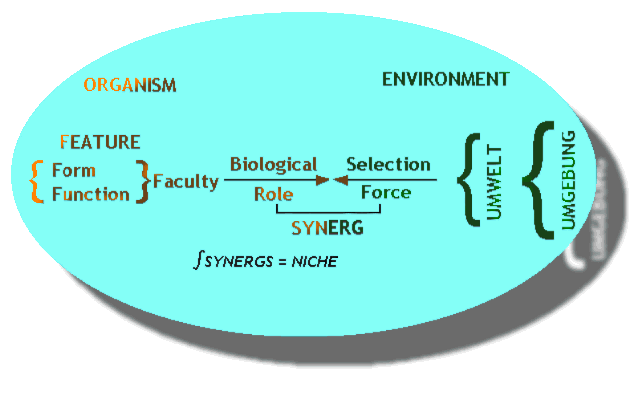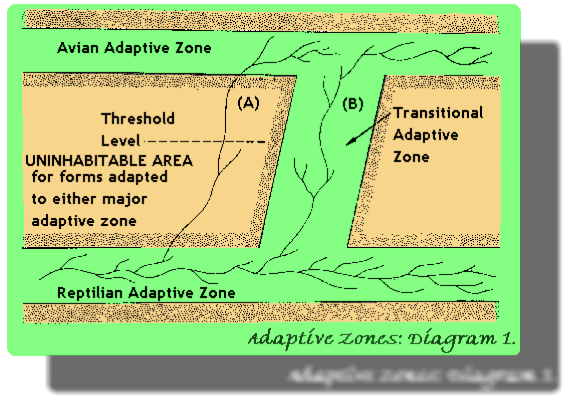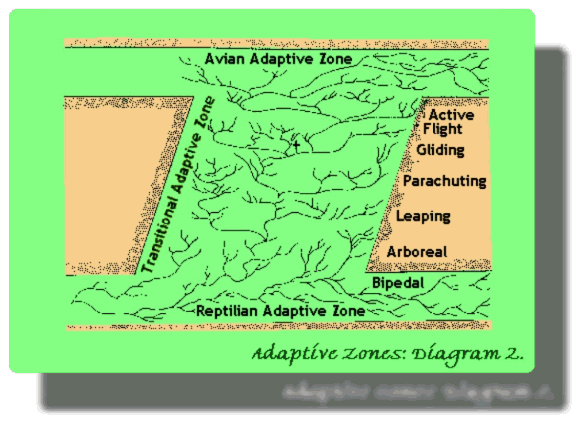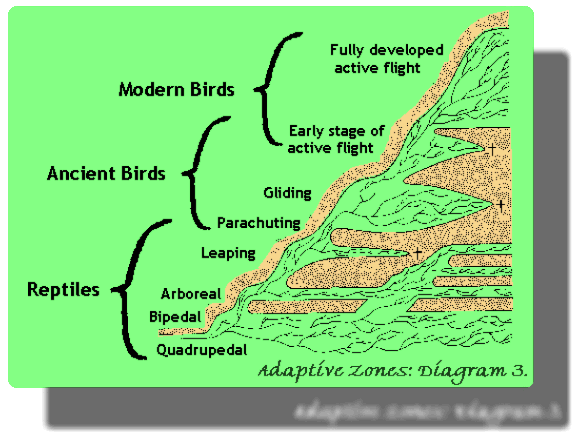 Back
to Opiliones Notes
Back
to Opiliones Notes| an Introductory Summary of some basic principles |  Back
to Opiliones Notes Back
to Opiliones Notes |
| with emphasis on Organism-Environment relationship |
Biological systems have unifying features - e.g.chemical composition,
cell structure and function.
But - they are also very diverse. So how do biologists tackle diversity
? - by means of systematics.
The objectives of biological systematics are:-
1. Classification is based on grouping of animals into those
of similar properties, i.e. phena, and placing these in definite named
taxonomic categories, i.e. taxa.
In other words, we can look through a collection of animals (or plants,
or other biological organisms) and sort them into sets containing similar
individuals (phena); once we recognise these, we can give them a name at
whatever taxonomic level we are working. A taxon (plural = taxa) is just
a phenon (plural = phena) plus a name. Taxonomy is that branch of systematics
which focusses on the description of taxa and the organisation of these
into classificatory schemes. Classification is the practical application
of taxonomic principles so that we can identify species - and place them
within a hierarchical system.
IMPORTANT: Classification purely on the basis of appearances (phenetics)
is not much use for biological understanding. It is also necessary to understand
the classification in terms of the underlying evolutionary processes which
have produced the taxonomic groups. This is fundamental to phylogenetic
systematics - and one modern approach is that of cladistics. An informative
glossary
of phylogenetic systematics has been written by Gunter Bechly.
2. Hierarchical system of categories is employed: in a sequence of decreasing size. In zoology the levels used are:- kingdom, phylum, class, order, family, genus, species. These can be further refined by grouping (e.g. super-family) or by intermediate splitting (e.g. sub-order, infra-order). By convention, the names of taxa at the various levels tend to have particular endings (e.g. -idae is a typical ending for the name of a family such as Linyphiidae).
3. Binomial system of nomenclature is used - genus + species
- which gives each animal a unique name; conventionally underlined or written
in italics to indicate specific usage. For example (and not keeping to
my favourites, Mitopus morio and Lepthyphantes zimmermanni!),
one of the nicest-looking and easily recognised familiar spider species
is the garden spider. If you don't know the English language its name "garden
spider" might not mean much to you (and I guess you'd be struggling to
read this page), but its scientific Latin name Araneus diadematus
applies to a rigorously defined species (according to type specimens) and
so means the same thing to arachnologists all over the world. Apart from
being so strictly defined, the species' proper name places it within the
hierarchical classification using the various taxonomic levels, thus:-
| Taxonomic level | Name (Araneus diadematus) the Garden Spider |
| Kingdom | Animalia |
| Phylum | Chelicerata |
| Class | Arachnida |
| Order | Araneae = Araneida |
| Sub-Order | Araneomorphae |
| Super-Family | Araneoidea |
| Family | Araneidae |
| Genus | Araneus |
| Species | diadematus |
Note some of the subtle differences in the names between some of the levels - you have to be very careful with your spelling!
4. SPECIES is the basic unit and has a real biological significance:-
defined as a group of organisms which can interbreed but which is reproductively
isolated from other such groups.
Thus a species forms a genetic unit with a shared gene pool; also forms
an ecological unit as members of a species interact with similar environmental
factors in much the same way. Thus a species is considered as a population
(not an individual), allowing for variation and evolutionary changes.
5. Difficulties with species recognition occur, e.g. uniparental
reproduction (asexual budding, parthenogenesis, etc.) polytypic species
(much variation in population), sibling species (look similar but are reproductively
isolated).
Remember that variation can occur through the course of an individual
animal's life: larvae may be very different from adults, males from females,
etc. A very wide range of taxonomic characters may be used encompassing
all aspects of the animals' biology; systematics is not merely concerned
with morphological and anatomical appearance. These characters may include
physiological and biochemical properties, ecological properties such as
habitat preferences, behavioural characteristics and special structures
such as genitalia. Some of the characters are important at species level
as they serve as the isolating mechanisms preventing interbreeding between
species - like the genital structures of spiders.
1. A complex set of interactions - some with environmental factors
- constitute an animal.
One way of approaching this is to appreciate that an animal is composed
of features; each feature has form and function; if
its function interacts with an environmental aspect (= selection force
in evolutionary terms) then it has a biological role ( a significance
for the animal).
The environment may be considered as the umwelt (immediate environment) and the umgebung (distant or potential environment). The many components of the umwelt and, less directly, the umgebung, may each have an influence in an evolutionary sense and thus comprise many selection forces which influence the animal.
A synerg is the interaction between a particular biological role
and the relevant selection force. The integration of all an animal's synergs
may be regarded as its NICHE.
In this way, one has the concept of the Form-Function Complex and its
significance in adaptation and evolution.
2. ADAPTATION - state of an animal 'adjusted' to its environment or process whereby an animal (or species) becomes suited to its environment. This can be considered in three ways or levels:
Any single adaptive feature of an animal must be compatible/integrated
with the rest of the animal's adaptations - they thus comprise an adaptive
suite of features. The characteristics of the arthropodan
species are a good example of an adaptive
suite.
3. Adaptation and Evolution. The concept of an adaptive
suite and the possibility of shifting relationships between organism and
environment enables us to imagine how one group of animals could evolve
from another. This is illustrated in the series below:-
| As shown in Diagram 1, a major group of animals occupies an adaptive
zone - with members of the group exhibiting the same sorts of organism/environment
adaptations. The sorts of adaptations shown by members of the group constitute
the adaptive suite of the group. The nature of the adaptive suite essentially
limits the group to a viable range of environmental conditions. The set
of organism-environment relationships can be called the "adaptive zone"
for that group. There will be sets of organism-environment interactions
which are non-viable - essentially uninhabitable areas in the adaptive
space.
To take two familiar groups of animals - the reptiles and the birds clearly inhabit different environments and have very different adaptive suites. We can thus refer to reptilian and an avian adaptive zones. But, it is also clear that the birds evolved from the reptiles (I'm not saying which!) and the shifting relationships between organisms and their environments must take place along a viable route - a transitional adaptive zone in which there is a gradual change. |
 |
| To put a few more details on to our model of evolution from reptiles
to birds, look at Diagram 2.
Here, you can see that it's not just a straight run through the transitional adaptive zone. On our diagram, you can see four points where an evolutionary line emerges from the reptilian adaptive zone, but only one of these eventually makes it through to the avian adaptive zone. Even that evolutionary line has many side-shoots which peter out within the transitional adaptive zone. The gradual shift in the animals is indicated, from bipedal locomotion (which frees the forelimbs for grasping) to arboreal (using the grasping forelimbs) and eventually through to active flight. |
 |
| Here, in Diagram 3, we've got a rather more detailed visualisation,
with some indication of intermediate forms occurring in the transitional
adaptive zone.
The time scale runs from left to right. Groups or evolutionary lines which die out are shown as blind ends. Groups which persist to the present (i.e. successful?) still show as open zones at the extreme right. Thus we can see that the ancient birds all died out, but as well as the typical quadrupedal reptiles, we still have some bipedal forms, as well as arboreal, leaping and even parachuting species. The gliding and early stages of flight have not persisted, but we can see a very wide avian adaptive zone reflecting the tremendous advantages of active flight. For an arboreal form, it's not good to have to descend to the ground (and perhaps been eaten by predators), so if you're leaping from tree to tree it's helpful if you don't fall (maybe fatally) to the ground) and the advantages of parachuting (soft landing), gliding (going to a further tree) and the flying (going as far as you like!) are obvious. |
 |
As you can see then, evolution to a higher group proceeds through a
transitional adaptive zone in which there is a shift in environmental factors.
Thus the animal/environment interaction is involved in evolution.
Whilst an individual organism's activities are directed towards maintaining stability in a variable environment, there is variation throughout the population to which it belongs. This variation in fitness through the population (largely as a result of sexual reproduction in most species), coupled with environmental variation is the driving force for evolution. (Darwin an all that stuff about natural selection...)
 |
Back to Opiliones Notes | or | Back to Arachnologia |
 |
Back to Home page |